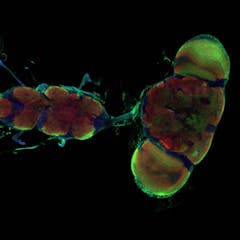
Articles on New research
Displaying 341 - 360 of 381 articles

DNA has been storing vast amounts of biological information for billions of years. Researchers are working to harness DNA for archiving data. A new method uses light to simplify the process.

New research shows that consumers are more likely to choose a plant-based meat option if they’re informed of their social benefits – or the environmental costs of beef consumption.

Chronic absenteeism is a pressing issue in high-poverty schools, but research suggests that serving students breakfast during class can help keep kids in school.

This finding was a surprise, since consumers actually seem to think liberals will provide better service.

At least half of Australians and New Zealanders in a recent study believed in one major conspiracy theory.

Long distances often preclude families in the Motor City from sending their kids to the best schools in the area, new research shows.

Adaptable neurons are tied to learning and memory but also to neurological disorders. By studying fruit flies, researchers found a mechanism that controls neuroplasticity.

At least one in 10 LGBTQA+ Australians are still vulnerable to religion-based practices to change or suppress their sexuality or gender identity.

Not all free college programs are the same. New research finds that eligibility requirements and other features influence outcomes.

A parent’s or grandparent’s stressful experiences change how their offspring behave. And it turns out that moms’ experiences produce different changes in kids than dads’.

Students who took part in the program scored 8% higher on the state science test than students who received traditional instruction, and demonstrated greater social and emotional learning.

Male rats transfer different hereditary information to their offspring depending on their age.

New research uncovers sizable gaps in how college students from different ethnic backgrounds trust the people in charge of their schools. Could a history of racism be to blame?

A community’s wastewater can predict coronavirus cases that haven’t yet been diagnosed. The quicker that information is known, the better.

We looked at newspaper coverage over 20 years and found 78% of articles portrayed domestic violence as isolated incidents in relationships, rather than a systemic issue.

New research suggests there’s often a mismatch between how you respond and what the other person wants to hear.

A new study found that while becoming a father gave men more leadership opportunities, becoming a mother diminished them for women.

New research shines a light on which students are most likely to enroll in community college when they find out it is free.

The spread of tawny crazy ants may be driven, in part, by their need for calcium. The calcium-rich limestone bedrock of the lower U.S. Midwest may provide ideal conditions for populations to explode.

When a community reopens its schools and COVID-19 rates increase, other factors – not the reopening of schools – may still be to blame, new research finds.
